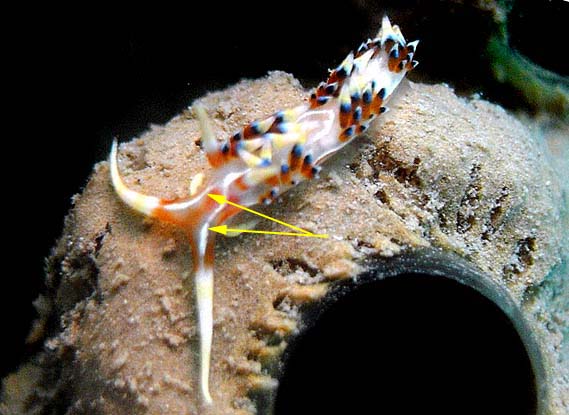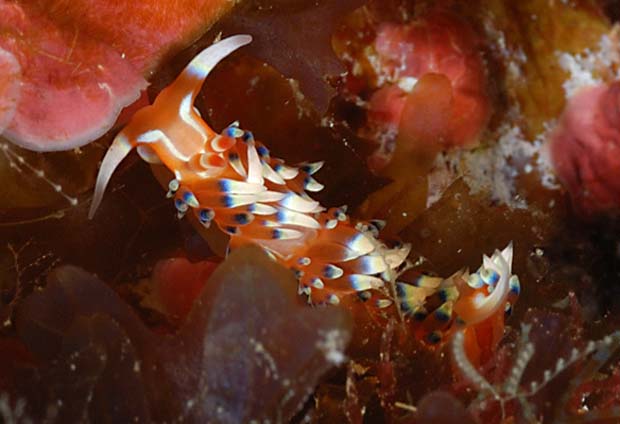This species has been observed on Réunion, Mayotte and Madagascar Islands
The translucent to translucent-orange body has a median longitudinal white line which branchs between the rhinophores, running to the oral tentacles of the orange head. The fusiform cerata are banded with orange, dark blue, and yellow and have white tips. |

|
|
| Showing species characteristics... | Photo Yann Oulia |
|
Remarks :
Identification confirmed by Nathalie Yonow
Some specialist like Rudman, Willan, Debelius use the genus Phidiana for indica et al. following Miller's papers, other like Gosliner use the genus Caloria
Synonymous : (according Worms)
- Learchis indica Bergh, 1896
- Phidiana indica (Bergh, 1896)
Bibliographic data :
In some cerata we can see the black digestive gland duct with the characteristic colours. In other there is a very narrow diffuse line of white between the blue and yellow.
In some specimen, the head is a deep red orange with a white line running from a ring around the base of each oral tentacle : it widens before turning a right angle and heading posteriorly to the base of the rhinophores where it meets and continues as a single line to the pericardium
The smooth and slender rhinophores are suffused with orange basally and lemon yellow distally or in other specimen orange tips and white medial bands
The head has very long and slender oral tentacles which are mostly white with a yellow band. In other specimen the basal third is transparent to translucent mauve, there is a yellow central ring and the tip is white.
The foot is paler, almost white.
The anterior foot corners are enlarge into pointed tentacle, and thus prominent. They have yellow pigmentation dorsally
Caloria indica is a hydroid feeder, but it is often seen crawling over other colonial animals such as sponges and corals and also over sea weeds. ). If feeds on hydroids : Pennaria disticha, Salacia tetracythara, Eudendrium sp...
Also placed in the genera Learchis , Phidiana , Hervia and Facelina by various authors. The correct generic placing cannot be resolved at present.
There are two similar species Caloria indica (also name as Phidiana indica ) et P. militaris. But one easy way to distinguish these two species is that in C. indica the head is orange with white lines while in P. militaris it is white with orange lines.
This species looks like Caloria sp. 1 and Caloria sp. 2 :
Caloria indica
Caloria sp. 1
Caloria sp. 2
Rhinophores structure
Smooth and slender rhinophores
Rhinophores translucent white with 2-3 oblique annulae
Smooth and slender rhinophores
Body coloration pattern
The translucent to translucent-orange body has a median longitudinal white line which branchs between the rhinophores, running to the oral tentacles of the orange head
Body orange to reddish with a line of opaque white patches on the medial portion of the notum
Body entirely pale translucent orange.
References :
Bill Rudman Seaslug site : Sea Slug Forum : Phidiana indica
Nudipixel Phidiana indica
Publications :
Bergh, L.S.R. (1896). Eolidiens d'Amboine. Voyage de MM. M. Bedot et C. Pictet dans l'Archipel Malais. Revue Suisse de Zoologie, 4 : 385-394, Pl. 16.
Rudman,W.B., 1980: Zoological Journal of the Linnean Society, 68(2): 139-172
Other photos of Caloria indica :
 |
Alain-Benoît Rassat Madagascar, Nosy bé, Ptérois, 10 m, 2 May 2013, size : 40 mm In this specimen, the smooth and slender rhinophores are suffused with orange basally and lemon yellow distally |
| Photo Freddy Fuentes and Nathalie Geffriaud |
There is a very heavily pigmented specimen The fusiform cerata are banded with orange (a), dark blue (b), and yellow (c) and have white tips.(d) |
 |
|
 |
Olivier Police Mayotte, "les piscines naturelles" des Badamiers, 1 m, 30 January 2010, size : 15 mm In this specimen, the smooth and
slender
rhinophores have orange tips a) and white medial bands (b) |
Fabrice Schubert Mayotte, Sakouli, 14 m, 1 octobre 2009, taille : 10-20 mm The translucent to translucent-orange body has a median longitudinal white line which branchs between the rhinophores(a), running to the oral tentacles of the orange head. In this specimen, the smooth and slender rhinophores are suffused with orange basally (b) and lemon yellow distally |
 |
 |
Isabelle Ruffin Réunion, Sec Jaune, 12 m, 5 April 2010, size : 20-25 mm, 4 specimens observed on this dive... In this specimen, the smooth and slender rhinophores have orange tip (a) , white medial band (b) and then orange basally (c)  |
More photos from Indian Ocean
Reunion, Caloria indica with the black digestive gland duct, at La Possession, by Sully Bachel
Reunion, Caloria indica with orange tips on the rhinophores, at Etang salé, by Yann Oulia
